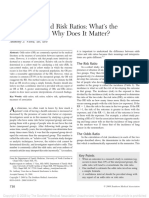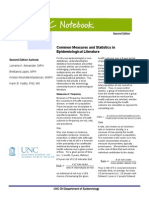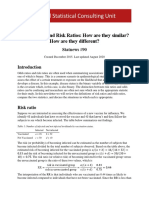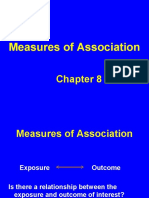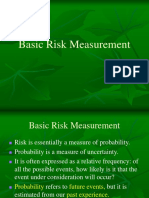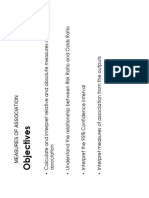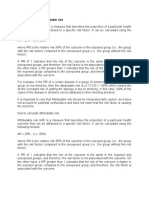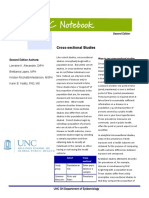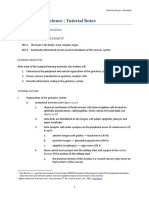Odds Ratios and Risk Ratios: What's The Difference and Why Does It Matter?
Odds Ratios and Risk Ratios: What's The Difference and Why Does It Matter?
Uploaded by
jorgegrodlCopyright:
Available Formats
Odds Ratios and Risk Ratios: What's The Difference and Why Does It Matter?
Odds Ratios and Risk Ratios: What's The Difference and Why Does It Matter?
Uploaded by
jorgegrodlOriginal Title
Copyright
Available Formats
Share this document
Did you find this document useful?
Is this content inappropriate?
Copyright:
Available Formats
Odds Ratios and Risk Ratios: What's The Difference and Why Does It Matter?
Odds Ratios and Risk Ratios: What's The Difference and Why Does It Matter?
Uploaded by
jorgegrodlCopyright:
Available Formats
CME Topic
Odds Ratios and Risk Ratios: What’s the
Difference and Why Does It Matter?
Anthony J. Viera, MD, MPH
it is important to understand the difference between odds
Abstract: Odds ratios (OR) are commonly reported in the medical
literature as the measure of association between exposure and out-
ratios and risk ratios because their meanings and interpreta-
come. However, it is relative risk that people more intuitively un-
tions are quite different.2,3
derstand as a measure of association. Relative risk can be directly
determined in a cohort study by calculating a risk ratio (RR). In The Risk Ratio
case-control studies, and in cohort studies in which the outcome In a cohort study, investigators begin by identifying the
occurs in less than 10% of the unexposed population, the OR pro- presence or absence of an exposure (eg, cigarette smoking) in
vides a reasonable approximation of the RR. However, when an two groups. They then follow the two groups over time (ie,
outcome is common (iÝ10% in the unexposed group), the OR will prospectively) to determine the number in each group who
exaggerate the RR. One method readers can use to estimate the RR develop the outcome of interest (eg, lung cancer). The num-
from an OR involves using a simple formula. Readers should also ber of people who develop the outcome divided by the total
look to see that a confidence interval is provided with any report of number in the group is called the incidence (Table 1). The
an OR or RR. A greater understanding of ORs and RRs allows incidence is what we call the risk of developing the outcome
readers to draw more accurate interpretations of research findings. in that group. The incidence (risk) in the exposed is then
divided by the incidence (risk) in the unexposed to determine
Key Words: odds ratios; risk ratios; relative risk; epidemiology; the ratio of the two risks: the risk ratio (RR), or relative risk.
measures of association This RR tells us how many times more likely the outcome
occurs among people with the risk factor (or exposure). If the
RR ⫽ 1, then the risk is the same in the two groups. If the RR
A s clinicians, we often want to know by how much a
patient’s risk of having a health outcome is increased or
decreased by the presence of some risk factor or exposure.
is ⬎1, the risk of the outcome is greater in those with the
exposure; and if the RR ⬍1, the risk of the outcome is lower
in those with the exposure. For example, a cohort study pre-
Investigators assist us in this manner by studying a group of
senting a RR of 15 for the association between cigarette smok-
people who have some risk factor (exposed group) and com-
ing and lung cancer tells us that the incidence of lung cancer
paring them with a group of people who do not have the risk
in the smokers was 15 times that of the incidence of lung
factor (unexposed group). After following both groups for
cancer in the nonsmokers.
some time, usually years, the investigators can determine how
many times more likely it was that the exposed group devel-
oped the outcome than the unexposed group. This number is The Odds Ratio
called the risk ratio, or “relative risk.” In certain study designs In the calculation of risk (incidence) in each of the two
or analytic techniques, however, the relative risk cannot be groups described above, the denominator in the ratio includes
determined directly, and investigators report relative odds. This that which is mathematically represented in the numerator. This
number is commonly called the odds ratio, and even authors of
research articles may interpret this ratio incorrectly.1 As readers,
Key Points
From the Department of Family Medicine, University of North Carolina at • When an outcome in a research study is common (eg,
Chapel Hill, Chapel Hill, NC.
occurs in more than 10% of the unexposed group), the
Reprint requests to Anthony J. Viera, MD, MPH, Department of Family Med-
icine, University of North Carolina at Chapel Hill, 590 Manning Drive, CB odds ratio will tend to overestimate the risk ratio.
7595, Chapel Hill, NC 27599. Email: anthony_viera@med.unc.edu • One method to estimate the odds ratio involves using
Dr. Anthony Viera has no financial disclosures to declare. a simple formula.
Accepted January 30, 2008. • A confidence interval should be provided along with
Copyright © 2008 by The Southern Medical Association any report of an odds ratio or risk ratio.
0038-4348/0⫺2000/10100-0730
730 © 2008 Southern Medical Association
You might also like
- ISO TS 24082 2021 Service Excellence - Designing Excellent ServiceDocument34 pagesISO TS 24082 2021 Service Excellence - Designing Excellent ServiceAntónio FerreiraNo ratings yet
- Jim Rohn - 12 PillarsDocument17 pagesJim Rohn - 12 PillarsMarco199897% (39)
- Uworld - INTERNAL MEDICINEDocument131 pagesUworld - INTERNAL MEDICINENikxyNo ratings yet
- Or & RR PDFDocument5 pagesOr & RR PDFjorgegrodlNo ratings yet
- Common Measures and Statistics in Epidemiological LiteratureDocument5 pagesCommon Measures and Statistics in Epidemiological LiteratureRenzo FernandezNo ratings yet
- A Most Odd Ratio - Interpreting and Describing Odds RatiosDocument5 pagesA Most Odd Ratio - Interpreting and Describing Odds RatiosAP KAPENo ratings yet
- Statistica Odds RatioDocument3 pagesStatistica Odds RatioAna-Mihaela BalanuțaNo ratings yet
- Epi Measuring Excess RiskDocument5 pagesEpi Measuring Excess RiskLaura muzingwaniNo ratings yet
- Risk & Causation: Frances Aviles MD MPH BsDocument47 pagesRisk & Causation: Frances Aviles MD MPH BsEthar LoveNo ratings yet
- Concept of Risk IN Pharmacoepidemiology: Mrs. Rihana Begum P Assistant Professor Department of Pharmacy PracticeDocument43 pagesConcept of Risk IN Pharmacoepidemiology: Mrs. Rihana Begum P Assistant Professor Department of Pharmacy PracticeJareena Begum100% (1)
- Risk Assessment IIDocument4 pagesRisk Assessment IICristhian AdrianzenNo ratings yet
- Measures of Public Health ImpactDocument2 pagesMeasures of Public Health ImpactEvans MogakaNo ratings yet
- Methodology and Research StudyDocument90 pagesMethodology and Research StudyAyman RagabNo ratings yet
- 08 Chapter 8Document37 pages08 Chapter 8Rida AwwalNo ratings yet
- Akobeng2008 (Recuperado)Document5 pagesAkobeng2008 (Recuperado)Grethel F. de GutiérrezNo ratings yet
- Basic Risk MeasurementDocument18 pagesBasic Risk Measurementgoku krishnaNo ratings yet
- Measures of AssociationDocument19 pagesMeasures of AssociationseoukieNo ratings yet
- Measures of Association and Impact 2020 EditedDocument107 pagesMeasures of Association and Impact 2020 EditedmussaNo ratings yet
- Relative RiskDocument8 pagesRelative Riskzhelle2No ratings yet
- Measures of Association - MBIOENGDocument54 pagesMeasures of Association - MBIOENGTendayi J GatsiNo ratings yet
- Risk TranscriptDocument14 pagesRisk TranscriptderieNo ratings yet
- The University of Jordan/ Faculty of Graduate Studies. Faculty of Medicine Family and Community Medicine DepartmentDocument39 pagesThe University of Jordan/ Faculty of Graduate Studies. Faculty of Medicine Family and Community Medicine DepartmentOhood ShunnarNo ratings yet
- Measures of AssociationDocument40 pagesMeasures of AssociationErmiasNo ratings yet
- Epidemiology Final Exam Outline:: Exposures.?Document33 pagesEpidemiology Final Exam Outline:: Exposures.?Farah FarahNo ratings yet
- CLS 351 Lecture Note 8Document41 pagesCLS 351 Lecture Note 8Abdelwahab AliNo ratings yet
- Tutorial About Hazard Ratios - Students 4 Best EvidenceDocument10 pagesTutorial About Hazard Ratios - Students 4 Best EvidenceHerry SasukeNo ratings yet
- 1.3 Concept of Risk in Pharmacoepideomology - Pharmacoepidemiology and PharmacoeconomicsDocument6 pages1.3 Concept of Risk in Pharmacoepideomology - Pharmacoepidemiology and PharmacoeconomicsKalra DarpanNo ratings yet
- Common Measures and Statistics in Epidemiological LiteratureDocument6 pagesCommon Measures and Statistics in Epidemiological LiteratureMayson BaliNo ratings yet
- Estimating Risk: Is There An Association?Document89 pagesEstimating Risk: Is There An Association?abdikani hassanNo ratings yet
- Assignment - Waiswa PeterDocument3 pagesAssignment - Waiswa PeterHamissiNo ratings yet
- Attributable Risk and Relative RiskDocument10 pagesAttributable Risk and Relative RisksurabhisprNo ratings yet
- Attributable Risk and Relative RiskDocument10 pagesAttributable Risk and Relative RisksurabhisprNo ratings yet
- EpidemiologyDocument16 pagesEpidemiologyKatina CamposNo ratings yet
- Kiss Guide To EBMDocument11 pagesKiss Guide To EBMBob2020No ratings yet
- Analytical Epidemiology: Dr. Eman Khammas Al-Sadi Chief of Community DepartmentDocument23 pagesAnalytical Epidemiology: Dr. Eman Khammas Al-Sadi Chief of Community DepartmentEman KhammasNo ratings yet
- Medpage Guide To Epi and BiostatisticsDocument11 pagesMedpage Guide To Epi and Biostatisticsnet2020100% (1)
- Measure of AssociationDocument38 pagesMeasure of Associationmitiku amareNo ratings yet
- 3.4 Cross-Sectional StudiesDocument4 pages3.4 Cross-Sectional StudiesRicardo Gomes100% (1)
- Epidemiological StudiesDocument25 pagesEpidemiological StudiesDr Sumit KarNo ratings yet
- L 7estimating RiskDocument63 pagesL 7estimating RiskRizwan ShameemNo ratings yet
- Incidence and Prevalence PDFDocument9 pagesIncidence and Prevalence PDFSreya SanilNo ratings yet
- Pub Health 324 Exam ReviewDocument2 pagesPub Health 324 Exam ReviewMikeNo ratings yet
- Relative Risk, Relative and Absolute Risk ReductiDocument2 pagesRelative Risk, Relative and Absolute Risk Reductirsaurabh396No ratings yet
- 3. Measures of AssociationDocument65 pages3. Measures of AssociationErick TzNo ratings yet
- RR or Etc 1Document10 pagesRR or Etc 1Thais KnoppNo ratings yet
- FirstAid 2017 PDFDocument412 pagesFirstAid 2017 PDFSylvia Diamond86% (7)
- Worksheet Appraisal AZALEADocument5 pagesWorksheet Appraisal AZALEAArini NurlelaNo ratings yet
- Cohort StudyDocument32 pagesCohort StudykelgroryNo ratings yet
- Concept of RiskDocument28 pagesConcept of RiskAswin DamodaranNo ratings yet
- Am J Clin Nutr-1999-Marshall-1351s-6sDocument6 pagesAm J Clin Nutr-1999-Marshall-1351s-6smensapertaNo ratings yet
- The Prevention of SchizophreniaDocument6 pagesThe Prevention of SchizophreniaMale BajoNo ratings yet
- Ukuran - Dampak - 2022Document99 pagesUkuran - Dampak - 2022Amelia Yuri KarlindaNo ratings yet
- WO14Document3 pagesWO14jafasoh293No ratings yet
- Lipkus 2019Document10 pagesLipkus 2019linhjlzuNo ratings yet
- 3.3 Case-Control StudiesDocument5 pages3.3 Case-Control StudiesRicardo GomesNo ratings yet
- Case Control StudyDocument6 pagesCase Control StudyAndre ChundawanNo ratings yet
- Measures of AssoDocument30 pagesMeasures of AssoSeare TekesteNo ratings yet
- Toxicities of Radiation Treatment for Breast Cancer: Risks and Management StrategiesFrom EverandToxicities of Radiation Treatment for Breast Cancer: Risks and Management StrategiesJean L. WrightNo ratings yet
- Preclinical Behavioral Science and Social Sciences Review 2023: For USMLE Step 1 and COMLEX-USA Level 1From EverandPreclinical Behavioral Science and Social Sciences Review 2023: For USMLE Step 1 and COMLEX-USA Level 1No ratings yet
- Supportive Care in Pediatric Oncology: A Practical Evidence-Based ApproachFrom EverandSupportive Care in Pediatric Oncology: A Practical Evidence-Based ApproachJames H. FeusnerNo ratings yet
- Psycho-Oncology for the Clinician: The Patient Behind the DiseaseFrom EverandPsycho-Oncology for the Clinician: The Patient Behind the DiseaseNo ratings yet
- Table 1. Calculating A Risk Ratio and An Odds Ratio in A Cohort Study Develop Outcome Do Not Develop OutcomeDocument1 pageTable 1. Calculating A Risk Ratio and An Odds Ratio in A Cohort Study Develop Outcome Do Not Develop OutcomejorgegrodlNo ratings yet
- Miller Chapman 2001Document9 pagesMiller Chapman 2001jorgegrodlNo ratings yet
- Page From Neurological Disorders Due To Systemic DiseaseDocument1 pagePage From Neurological Disorders Due To Systemic DiseasejorgegrodlNo ratings yet
- Page From Medical Microbiology A Guide To Microbial InfectionsDocument1 pagePage From Medical Microbiology A Guide To Microbial InfectionsjorgegrodlNo ratings yet
- Page From Neurological Disorders Due To Systemic Disease (B-Ok - CC)Document1 pagePage From Neurological Disorders Due To Systemic Disease (B-Ok - CC)jorgegrodlNo ratings yet
- Page From LOLST1MAY15Document1 pagePage From LOLST1MAY15jorgegrodlNo ratings yet
- GustationDocument3 pagesGustationjorgegrodlNo ratings yet
- Olfaction PDFDocument5 pagesOlfaction PDFjorgegrodl100% (1)
- A Pattern Recognition Approach To Myopathy. CONTINUUMDocument24 pagesA Pattern Recognition Approach To Myopathy. CONTINUUMjorgegrodlNo ratings yet
- Origin of LifeDocument36 pagesOrigin of LifejorgegrodlNo ratings yet
- Page From Thompson Thompson Genetics in Medicine 8Document2 pagesPage From Thompson Thompson Genetics in Medicine 8jorgegrodlNo ratings yet
- Scrib D 4Document21 pagesScrib D 4Orsu HarishNo ratings yet
- Security Full KaziDocument19 pagesSecurity Full KaziAMBELEMBIJENo ratings yet
- Chalet Book: Font Installation InstructionsDocument5 pagesChalet Book: Font Installation InstructionsRonaldNo ratings yet
- Google Interview QuestionsDocument7 pagesGoogle Interview QuestionsAbhishek BansalNo ratings yet
- To Kill A Mockingbird - Example of Escape andDocument6 pagesTo Kill A Mockingbird - Example of Escape andCatherine Nicole SamsonNo ratings yet
- 20 Physicists Who Revolutionised Our Understanding of The WorldDocument7 pages20 Physicists Who Revolutionised Our Understanding of The WorldChincel AniNo ratings yet
- GP Drug List Full-130505Document14 pagesGP Drug List Full-130505zilott90No ratings yet
- FMG90 Series: With PVDF and 316L ConstructionDocument2 pagesFMG90 Series: With PVDF and 316L ConstructionRavi RanjanNo ratings yet
- IGCSE Board Exam Timetable - 2024Document3 pagesIGCSE Board Exam Timetable - 2024shukla.abheek100% (1)
- Course 1Document2 pagesCourse 1Tuan Anh TranNo ratings yet
- Introduction To Economics-1Document29 pagesIntroduction To Economics-1WASSWA ALEXNo ratings yet
- Q3 - Sci 9 Lesson Plan 4Document16 pagesQ3 - Sci 9 Lesson Plan 4Jo BontilaoNo ratings yet
- Python Module 4Document115 pagesPython Module 4SANAL KUMARNo ratings yet
- Lab Exercises 4Document5 pagesLab Exercises 4koaslosa0% (2)
- Seminar Report: Hyperloop TrainDocument13 pagesSeminar Report: Hyperloop TrainKishan AvmNo ratings yet
- SpeechDocument4 pagesSpeechRaiyad RezaNo ratings yet
- Osv Class AbsDocument40 pagesOsv Class AbsAhmad ImranNo ratings yet
- Stream CipherDocument16 pagesStream CipherSanjeev KumarNo ratings yet
- SurveyDocument2 pagesSurveyhelloNo ratings yet
- At L La Grade 8 Past PerfectDocument4 pagesAt L La Grade 8 Past PerfectJoseane de Lima MartinsNo ratings yet
- Lab 4 - DMFCDocument11 pagesLab 4 - DMFCNeel NadparaNo ratings yet
- جزوه درس رادارDocument121 pagesجزوه درس رادارbahram bahramiNo ratings yet
- EspecificacionesDocument3 pagesEspecificacionesMAURICIO MORALESNo ratings yet
- Spectacular Examples of Foundation FailuresDocument14 pagesSpectacular Examples of Foundation FailuresEugene CardamaNo ratings yet
- Brgy Gulod Community Study (2008) (Binangonan, Rizal, Region 4A, Philippines)Document84 pagesBrgy Gulod Community Study (2008) (Binangonan, Rizal, Region 4A, Philippines)John Nicer AbletisNo ratings yet
- Plant Pests: Margaret Chapman Cal Poly, San Luis ObispoDocument24 pagesPlant Pests: Margaret Chapman Cal Poly, San Luis ObispoHeather DoyleNo ratings yet
- Bullet GraphDocument13 pagesBullet GraphRahul JainNo ratings yet
- Dbms 2021Document74 pagesDbms 2021andiNo ratings yet



